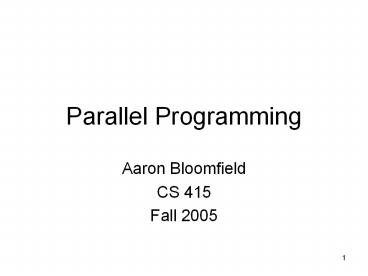Parallel%20Programming - PowerPoint PPT Presentation
Title:
Parallel%20Programming
Description:
Each Processor has direct access only to its local memory ... Buffered/unbuffered. Predefined and derived datatypes. Virtual topologies. Parallel I/O (MPI 2) ... – PowerPoint PPT presentation
Number of Views:21
Avg rating:3.0/5.0
Title: Parallel%20Programming
1
Parallel Programming
- Aaron Bloomfield
- CS 415
- Fall 2005
2
Why Parallel Programming?
- Predict weather
- Predict spread of SARS
- Predict path of hurricanes
- Predict oil slick propagation
- Model growth of bio-plankton/fisheries
- Structural simulations
- Predict path of forest fires
- Model formation of galaxies
- Simulate nuclear explosions
3
Code that can be parallelized
- do i 1 to max,
- ai bi ci di
- end do
4
Parallel Computers
- Programming mode types
- Shared memory
- Message passing
5
Distributed Memory Architecture
- Each Processor has direct access only to its
local memory - Processors are connected via high-speed
interconnect - Data structures must be distributed
- Data exchange is done via explicit
processor-to-processor communication
send/receive messages - Programming Models
- Widely used standard MPI
- Others PVM, Express, P4, Chameleon, PARMACS, ...
6
Message Passing Interface
- MPI provides
- Point-to-point communication
- Collective operations
- Barrier synchronization
- gather/scatter operations
- Broadcast, reductions
- Different communication modes
- Synchronous/asynchronous
- Blocking/non-blocking
- Buffered/unbuffered
- Predefined and derived datatypes
- Virtual topologies
- Parallel I/O (MPI 2)
- C/C and Fortran bindings
- http//www.mpi-forum.org
7
Shared Memory Architecture
- Processors have direct access to global memory
and I/O through bus or fast switching network - Cache Coherency Protocol guarantees consistency
of memory and I/O accesses - Each processor also has its own memory (cache)
- Data structures are shared in global address
space - Concurrent access to shared memory must be
coordinated - Programming Models
- Multithreading (Thread Libraries)
- OpenMP
8
OpenMP
- OpenMP portable shared memory parallelism
- Higher-level API for writing portable
multithreaded applications - Provides a set of compiler directives and library
routines for parallel application programmers - API bindings for Fortran, C, and C
- http//www.OpenMP.org
9
(No Transcript)
10
Approaches
- Parallel Algorithms
- Parallel Language
- Message passing (low-level)
- Parallelizing compilers
11
Parallel Languages
- CSP - Hoares notation for parallelism as a
network of sequential processes exchanging
messages. - Occam - Real language based on CSP. Used for the
transputer, in Europe.
12
Fortran for parallelism
- Fortran 90 - Array language. Triplet notation
for array sections. Operations and intrinsic
functions possible on array sections. - High Performance Fortran (HPF) - Similar to
Fortran 90, but includes data layout
specifications to help the compiler generate
efficient code.
13
More parallel languages
- ZPL - array-based language at UW. Compiles into
C code (highly portable). - C - C extended for parallelism
14
Object-Oriented
- Concurrent Smalltalk
- Threads in Java, Ada, thread libraries for use in
C/C - This uses a library of parallel routines
15
Functional
- NESL, Multiplisp
- Id Sisal (more dataflow)
16
Parallelizing Compilers
- Automatically transform a sequential program into
a parallel program. - Identify loops whose iterations can be executed
in parallel. - Often done in stages.
- Q Which loops can be run in parallel?
- Q How should we distribute the work/data?
17
Data Dependences
- Flow dependence - RAW. Read-After-Write. A
"true" dependence. Read a value after it has
been written into a variable. - Anti-dependence - WAR. Write-After-Read. Write
a new value into a variable after the old value
has been read. - Output dependence - WAW. Write-After-Write.
Write a new value into a variable and then later
on write another value into the same variable.
18
Example
- 1 A 90
- 2 B A
- 3 C A D
- 4 A 5
19
Dependencies
- A parallelizing compiler must identify loops that
do not have dependences BETWEEN ITERATIONS of the
loop. - Example
- do I 1, 1000
- A(I) B(I) C(I)
- D(I) A(I)
- end do
20
Example
- Fork one thread for each processor
- Each thread executes the loop
- do I my_lo, my_hi
- A(I) B(I) C(I)
- D(I) A(I)
- end do
- Wait for all threads to finish before proceeding.
21
Another Example
- do I 1, 1000
- A(I) B(I) C(I)
- D(I) A(I1)
- end do
22
Yet Another Example
- do I 1, 1000
- A( X(I) ) B(I) C(I)
- D(I) A( X(I) )
- end do
23
Parallel Compilers
- Two concerns
- Parallelizing code
- Compiler will move code around to uncover
parallel operations - Data locality
- If a parallel operation has to get data from
another processors memory, thats bad
24
Distributed computing
- Take a big task that has natural parallelism
- Split it up to may different computers across a
network - Examples SETI_at_Home, prime number searches,
Google Compute, etc. - Distributed computing is a form of parallel
computing
















![High-level%20Multithreaded%20Programming%20[Part%20III] PowerPoint PPT Presentation](https://s3.amazonaws.com/images.powershow.com/8411512.th0.jpg?_=20190728049)














